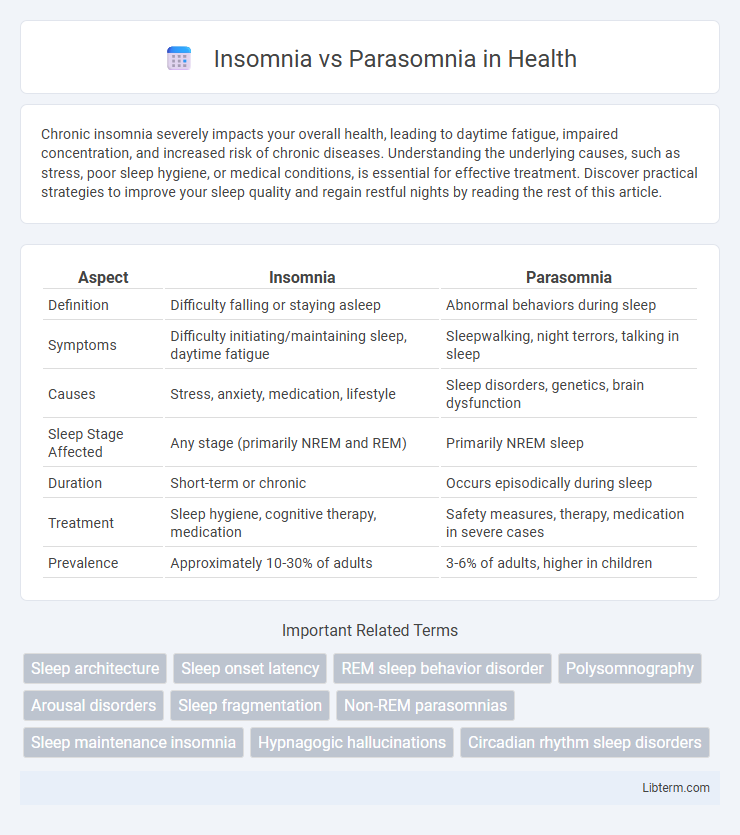Chronic insomnia severely impacts your overall health, leading to daytime fatigue, impaired concentration, and increased risk of chronic diseases. Understanding the underlying causes, such as stress, poor sleep hygiene, or medical conditions, is essential for effective treatment. Discover practical strategies to improve your sleep quality and regain restful nights by reading the rest of this article.
Table of Comparison
| Aspect | Insomnia | Parasomnia |
|---|---|---|
| Definition | Difficulty falling or staying asleep | Abnormal behaviors during sleep |
| Symptoms | Difficulty initiating/maintaining sleep, daytime fatigue | Sleepwalking, night terrors, talking in sleep |
| Causes | Stress, anxiety, medication, lifestyle | Sleep disorders, genetics, brain dysfunction |
| Sleep Stage Affected | Any stage (primarily NREM and REM) | Primarily NREM sleep |
| Duration | Short-term or chronic | Occurs episodically during sleep |
| Treatment | Sleep hygiene, cognitive therapy, medication | Safety measures, therapy, medication in severe cases |
| Prevalence | Approximately 10-30% of adults | 3-6% of adults, higher in children |
Introduction to Sleep Disorders
Sleep disorders encompass a variety of conditions that disrupt normal sleep patterns, with insomnia and parasomnia being two prevalent types. Insomnia primarily involves difficulty falling or staying asleep, leading to insufficient restorative sleep and daytime impairment. Parasomnia, in contrast, includes abnormal behaviors or experiences during sleep, such as sleepwalking, night terrors, and REM sleep behavior disorder, often occurring during transitions between sleep stages.
What is Insomnia?
Insomnia is a common sleep disorder characterized by difficulty falling asleep, staying asleep, or obtaining restorative sleep, despite adequate opportunity and circumstances for sleep. It often leads to daytime fatigue, impaired concentration, and decreased overall quality of life. Chronic insomnia can be caused by stress, anxiety, medical conditions, or environmental factors, requiring medical evaluation for effective management.
What is Parasomnia?
Parasomnia refers to a group of sleep disorders characterized by abnormal behaviors, movements, emotions, perceptions, or dreams occurring during sleep transitions, such as sleepwalking, night terrors, and REM sleep behavior disorder. Unlike insomnia, which involves difficulty falling or staying asleep, parasomnia disrupts normal sleep patterns through involuntary actions. Understanding parasomnia is essential for accurate diagnosis and treatment to prevent injury and improve sleep quality.
Key Differences Between Insomnia and Parasomnia
Insomnia primarily involves difficulty falling asleep or staying asleep, leading to insufficient or poor-quality rest, whereas parasomnia encompasses abnormal behaviors or experiences during sleep, such as sleepwalking, night terrors, or REM sleep behavior disorder. Insomnia is characterized by disrupted sleep initiation or maintenance without unusual physical activities, while parasomnia features involuntary actions or unusual movements occurring during different sleep stages. Treatment approaches differ as insomnia often responds to cognitive-behavioral therapy or sleep hygiene improvements, whereas parasomnia management may require addressing underlying neurological or psychiatric conditions.
Causes of Insomnia
Insomnia primarily stems from stress, anxiety, depression, and poor sleep habits, disrupting the natural sleep cycle. Medical conditions such as chronic pain, asthma, and neurological disorders also contribute significantly to insomnia development. Environmental factors like noise, light, and irregular work schedules further exacerbate difficulty in falling or staying asleep.
Causes of Parasomnia
Parasomnias are caused by disruptions in the brain's transition between sleep stages, often triggered by stress, sleep deprivation, or neurological conditions such as Parkinson's disease. Genetic predisposition and environmental factors, like sleep environment or medication use, also contribute significantly to the occurrence of parasomnia episodes. Unlike insomnia, which primarily involves difficulty falling or staying asleep, parasomnias manifest as abnormal behaviors during sleep, including sleepwalking, night terrors, and REM sleep behavior disorder.
Symptoms: Insomnia vs Parasomnia
Insomnia symptoms include difficulty falling asleep, frequent awakenings during the night, and waking up feeling unrefreshed, often leading to daytime fatigue and irritability. Parasomnia symptoms involve abnormal behaviors during sleep such as sleepwalking, night terrors, and REM sleep behavior disorder, which can cause physical movements or vocalizations. Both sleep disorders disrupt normal sleep patterns but differ in manifestation: insomnia primarily affects sleep initiation and maintenance, while parasomnia involves unusual physical activities during sleep.
Diagnosis and Assessment Methods
Insomnia diagnosis primarily involves clinical interviews, sleep diaries, and polysomnography to evaluate sleep patterns and identify underlying causes. Parasomnia assessment requires detailed patient history, overnight video polysomnography, and sometimes actigraphy to capture abnormal behaviors and neurological events during sleep. Both conditions benefit from standardized questionnaires such as the Insomnia Severity Index (ISI) and the Parasomnia Severity Scale (PSS) to quantify symptom severity and guide treatment.
Treatment Options for Both Conditions
Treatment options for insomnia primarily include cognitive-behavioral therapy for insomnia (CBT-I), which targets negative sleep habits and anxiety, alongside medications such as sedative-hypnotics or melatonin receptor agonists for short-term relief. Parasomnia management varies based on the specific disorder, with safety measures to prevent injury, stress reduction techniques, and medications like benzodiazepines or antidepressants used for conditions such as REM sleep behavior disorder or sleepwalking. Both conditions benefit from sleep hygiene improvements, lifestyle modifications, and, in certain cases, addressing underlying medical or psychiatric issues to enhance overall sleep quality and safety.
Preventive Tips and Sleep Hygiene
Effective prevention of insomnia and parasomnia involves maintaining consistent sleep hygiene practices such as establishing a regular sleep schedule, creating a calming bedtime routine, and optimizing the sleep environment by minimizing noise and light. Avoiding stimulants like caffeine and electronic device usage before bedtime can reduce sleep disruptions and parasomnia occurrences. Implementing stress management techniques such as mindfulness or relaxation exercises supports uninterrupted sleep and lowers the risk of insomnia.
Insomnia Infographic

 libterm.com
libterm.com